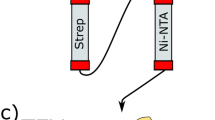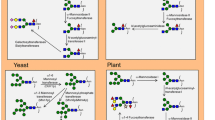Abstract
Key message
We successfully developed a method for metabolic isotope labeling of recombinant proteins produced in transgenic tobacco. This enabled assessment of structural integrity of plant-derived therapeutic antibodies by NMR analysis.
Abstract
A variety of expression vehicles have been developed for the production of promising biologics, including plants, fungi, bacteria, insects, and mammals. Glycoprotein biologics often experience altered folding and post-translational modifications that are typified by variant glycosylation patterns. These differences can dramatically affect their efficacy, as exemplified by therapeutic antibodies. However, it is generally difficult to validate the structural integrity of biologics produced using different expression vehicles. To address this issue, we have developed and applied a stable-isotope-assisted nuclear magnetic resonance (NMR) spectroscopy method for the conformational characterization of recombinant antibodies produced in plants. Nicotiana benthamiana used as a vehicle for the production of recombinant immunoglobulin G (IgG) was grown in a 15N-enriched plant growth medium. The Fc fragment derived from the 15N-labeled antibody thus prepared was subjected to heteronuclear two-dimensional (2D) NMR measurements. This approach enabled assessment of the structural integrity of the plant-derived therapeutic antibodies by comparing their NMR spectral properties with those of an authentic IgG-Fc derived from mammalian cells.




Similar content being viewed by others
References
Bakker H, Bardor M, Molthoff JW, Gomord V, Elbers I, Stevens LH, Jordi W, Lommen A, Faye L, Lerouge P, Bosch D (2001) Galactose-extended glycans of antibodies produced by transgenic plants. Proc Natl Acad Sci U S A 98(5):2899–2904. doi:10.1073/pnas.031419998
Burton DR, Woof JM (1992) Human antibody effector function. Adv Immunol 51:1–84
Cabanes-Macheteau M, Fitchette-Laine AC, Loutelier-Bourhis C, Lange C, Vine ND, Ma JK, Lerouge P, Faye L (1999) N-Glycosylation of a mouse IgG expressed in transgenic tobacco plants. Glycobiology 9(4):365–372
Cegelski L, Schaefer J (2006) NMR determination of photorespiration in intact leaves using in vivo 13CO2 labeling. J Magn Reson 178(1):1–10. doi:10.1016/j.jmr.2005.10.010
Chen Q, Santi L, Zhang C (2014) Plant-made biologics. Biomed Res Int 2014:418064. doi:10.1155/2014/418064
Cox KM, Sterling JD, Regan JT, Gasdaska JR, Frantz KK, Peele CG, Black A, Passmore D, Moldovan-Loomis C, Srinivasan M, Cuison S, Cardarelli PM, Dickey LF (2006) Glycan optimization of a human monoclonal antibody in the aquatic plant Lemna minor. Nat Biotechnol 24(12):1591–1597. doi:10.1038/nbt1260
Delaglio F, Grzesiek S, Vuister GW, Zhu G, Pfeifer J, Bax A (1995) NMR Pipe: a multidimensional spectral processing system based on UNIX pipes. J Biomol NMR 6(3):277–293
DeLano WL (2002) The PyMOL Molecular Graphics System. DeLano Scientific, San Carlos
Dübel S (2007) Recombinant therapeutic antibodies. Appl Microbiol Biotechnol 74(4):723–729. doi:10.1007/s00253-006-0810-y
Goddard T, Kneller D (1993) SPARKY 3. University of California, San Francisco
He J, Lai H, Engle M, Gorlatov S, Gruber C, Steinkellner H, Diamond MS, Chen Q (2014) Generation and analysis of novel plant-derived antibody-based therapeutic molecules against West Nile virus. PLoS One 9(3):e93541. doi:10.1371/journal.pone.0093541
Horsch RB, Klee HJ, Stachel S, Winans SC, Nester EW, Rogers SG, Fraley RT (1986) Analysis of Agrobacterium tumefaciens virulence mutants in leaf discs. Proc Natl Acad Sci U S A 83(8):2571–2575
Houde D, Peng Y, Berkowitz SA, Engen JR (2010) Post-translational modifications differentially affect IgG1 conformation and receptor binding. Mol Cell Proteomics 9(8):1716–1728. doi:10.1074/mcp.M900540-MCP200
Idusogie EE, Presta LG, Gazzano-Santoro H, Totpal K, Wong PY, Ultsch M, Meng YG, Mulkerrin MG (2000) Mapping of the C1q binding site on rituxan, a chimeric antibody with a human IgG1 Fc. J Immunol 164(8):4178–4184 (ji_v164n8p4178)
Ippel JH, Pouvreau L, Kroef T, Gruppen H, Versteeg G, van den Putten P, Struik PC, van Mierlo CP (2004) In vivo uniform 15N-isotope labelling of plants: using the greenhouse for structural proteomics. Proteomics 4(1):226–234. doi:10.1002/pmic.200300506
Jefferis R, Lund J, Pound JD (1998) IgG-Fc-mediated effector functions: molecular definition of interaction sites for effector ligands and the role of glycosylation. Immunol Rev 163:59–76
Kaulfurst-Soboll H, Rips S, Koiwa H, Kajiura H, Fujiyama K, von Schaewen A (2011) Reduced immunogenicity of Arabidopsis hgl1 mutant N-glycans caused by altered accessibility of xylose and core fucose epitopes. J Biol Chem 286(26):22955–22964. doi:10.1074/jbc.M110.196097
Loos A, Steinkellner H (2012) IgG-Fc glycoengineering in non-mammalian expression hosts. Arch Biochem Biophys 526(2):167–173. doi:10.1016/j.abb.2012.05.011
Matsumiya S, Yamaguchi Y, Saito J, Nagano M, Sasakawa H, Otaki S, Satoh M, Shitara K, Kato K (2007) Structural comparison of fucosylated and nonfucosylated Fc fragments of human immunoglobulin G1. J Mol Biol 368(3):767–779. doi:10.1016/j.jmb.2007.02.034
Matsuo K, Kagaya U, Itchoda N, Tabayashi N, Matsumura T (2014) Deletion of plant-specific sugar residues in plant N-glycans by repression of GDP-d-mannose 4,6-dehydratase and b-1,2-xylosyltransferase genes. J Biosci Bioeng. doi:10.1016/j.jbiosc.2014.04.005
Mizushima T, Yagi H, Takemoto E, Shibata-Koyama M, Isoda Y, Iida S, Masuda K, Satoh M, Kato K (2011) Structural basis for improved efficacy of therapeutic antibodies upon defucosylation of their Fc glycans. Genes Cells 16(11):1071–1080. doi:10.1111/j.1365-2443.2011.01552.x
Mylne JS, Craik DJ (2008) 15N cyclotides by whole plant labeling. Biopolymers 90(4):575–580. doi:10.1002/bip.21012
Rau R (2002) Adalimumab (a fully human anti-tumour necrosis factor alpha monoclonal antibody) in the treatment of active rheumatoid arthritis: the initial results of five trials. Ann Rheum Dis. doi:10.1136/ard.61.suppl_2.ii70
Schahs M, Strasser R, Stadlmann J, Kunert R, Rademacher T, Steinkellner H (2007) Production of a monoclonal antibody in plants with a humanized N-glycosylation pattern. Plant Biotechnol J 5(5):657–663. doi:10.1111/j.1467-7652.2007.00273.x
Strasser R, Altmann F, Mach L, Glossl J, Steinkellner H (2004) Generation of Arabidopsis thaliana plants with complex N-glycans lacking b1,2-linked xylose and core a1,3-linked fucose. FEBS Lett 561(1–3):132–136. doi:10.1016/S0014-5793(04)00150-4
Takahashi N, Kato K (2003) GALAXY(glycoanalysis by the three axes of MS and chromatography):a web application that assists structural analyses of N-glycans. Trends Glycosci Glycotech 15(84):235–251
Vranken WF, Boucher W, Stevens TJ, Fogh RH, Pajon A, Llinas M, Ulrich EL, Markley JL, Ionides J, Laue ED (2005) The CCPN data model for NMR spectroscopy: development of a software pipeline. Proteins 59(4):687–696
Yagi H, Yamamoto M, Yu SY, Takahashi N, Khoo KH, Lee YC, Kato K (2010) N-Glycosylation profiling of turtle egg yolk: expression of galabiose structure. Carbohydr Res 345(3):442–448. doi:10.1016/j.carres.2009.12.002
Yagi H, Saito T, Yanagisawa M, Yu RK, Kato K (2012) Lewis X-carrying N-glycans regulate the proliferation of mouse embryonic neural stem cells via the Notch signaling pathway. J Biol Chem 287(29):24356–24364. doi:10.1074/jbc.M112.365643
Yagi H, Zhang Y, Yagi-Utsumi M, Yamaguchi T, Iida S, Yamaguchi Y, Kato K (2014) Backbone 1H, 13C, and 15N resonance assignments of the Fc fragment of human immunoglobulin G glycoprotein. Biomol NMR assign. doi:10.1007/s12104-014-9586-7 (in press)
Yamaguchi Y, Kim H, Kato K, Masuda K, Shimada I, Arata Y (1995) Proteolytic fragmentation with high specificity of mouse immunoglobulin G. Mapping of proteolytic cleavage sites in the hinge region. J Immunol Methods 181(2):259–267
Yamaguchi Y, Nishimura M, Nagano M, Yagi H, Sasakawa H, Uchida K, Shitara K, Kato K (2006) Glycoform-dependent conformational alteration of the Fc region of human immunoglobulin G1 as revealed by NMR spectroscopy. Biochim Biophys Acta 1760(4):693–700. doi:10.1016/j.bbagen.2005.10.002
Yamaguchi Y, Takahashi N, Kato K (2007) Molecular interactions: Antibody structures. In: Kamerling JP (ed) Comprehensive glycoscience, vol 3. Elsevier, Oxford, pp 745–763
Zeitlin L, Pettitt J, Scully C, Bohorova N, Kim D, Pauly M, Hiatt A, Ngo L, Steinkellner H, Whaley KJ, Olinger GG (2011) Enhanced potency of a fucose-free monoclonal antibody being developed as an Ebola virus immunoprotectant. Proc Natl Acad Sci U S A 108(51):20690–20694. doi:10.1073/pnas.1108360108
Acknowledgments
This work was supported, in part, by the Program for the Promotion of Fundamental Studies in Health Sciences of the National Institute of Biomedical Innovation (NIBIO), and by Grants-in-Aid for Scientific Research (24249002, 25102008, and 25860053) from the Ministry of Education, Culture, Sports, Science and Technology (MEXT). This work was partly supported by the Nanotechnology Platform Program (Molecule and Material Synthesis) of MEXT. We gratefully acknowledge Drs. Minoru Tada and Akiko Ishii-Watabe (National Institute of Health Sciences) for providing ADM expression vector for mammalian cells. We also thank Ms. Kiyomi Senda and Ms. Kumiko Hattori (Nagoya City University) for their help in purification of IgG.
Author information
Authors and Affiliations
Corresponding authors
Additional information
Communicated by E. Benvenuto.
Electronic supplementary material
Below is the link to the electronic supplementary material.
299_2015_1757_MOESM1_ESM.pptx
Supplementary material 1 Supplemental Fig. 1: Detection of glycopeptides in the chromatogram of a tryptic digest of nonlabeled and 15N-labeled IgG expressed in transgenic tobacco.Supplemental Fig. 2: Typical MS spectra of the observed peptides (HC1:VSYLSTASSLDYWGQGTLVTVSSASTK) derived from non-labeled (upper) and 15N-labeled (lower) IgGs produced in transgenic tobacco.Supplemental Fig. 3: Detection of purified Fc fragments derived from transgenic tobacco and CHO cells by Coomassie Brilliant Blue staining of SDS-PAGE gels under non-reducing condition.Supplemental Fig. 4: Superposition of 1H–15N HSQC spectra of the uniformly 15N-labeled IgG-Fc fragments derived from transgenic tobacco (black) and CHO cells (red). The HSQC spectrum of CHO-produced IgG-Fc was adapted from the literature (Yagi et al. 2014). (PPTX 854 kb)
Rights and permissions
About this article
Cite this article
Yagi, H., Fukuzawa, N., Tasaka, Y. et al. NMR-based structural validation of therapeutic antibody produced in Nicotiana benthamiana . Plant Cell Rep 34, 959–968 (2015). https://doi.org/10.1007/s00299-015-1757-1
Received:
Revised:
Accepted:
Published:
Issue Date:
DOI: https://doi.org/10.1007/s00299-015-1757-1




